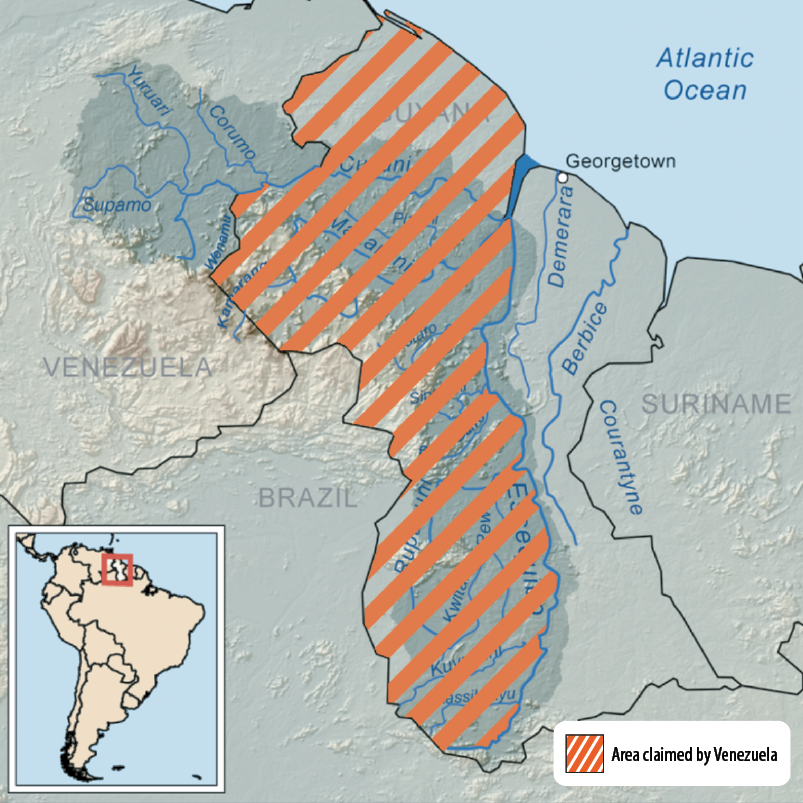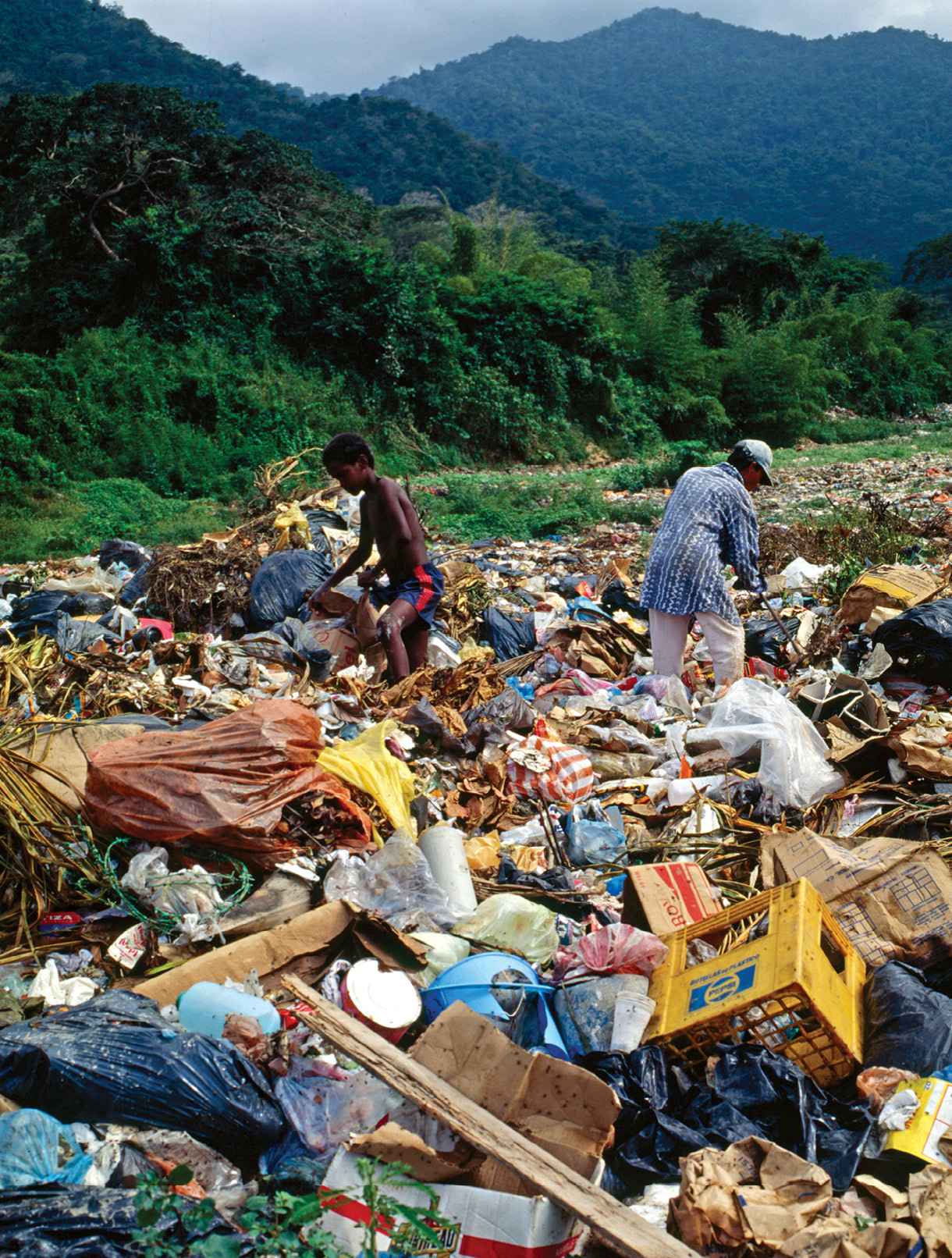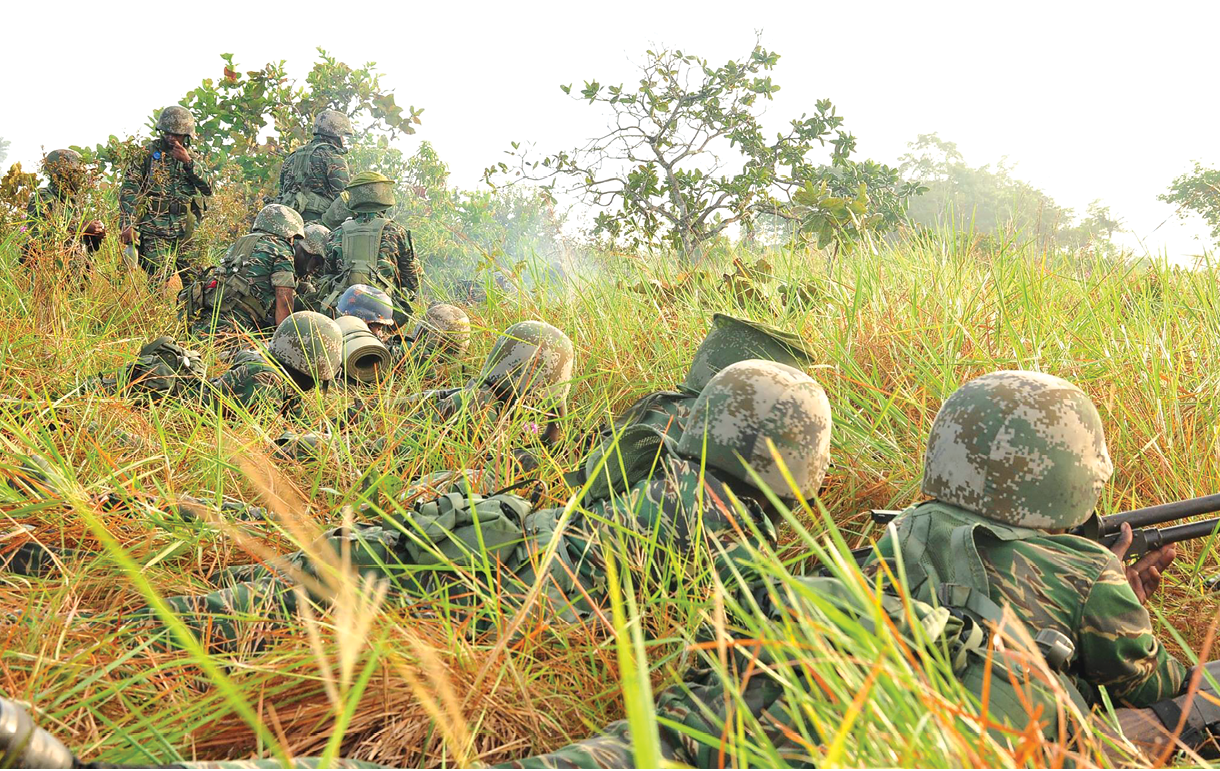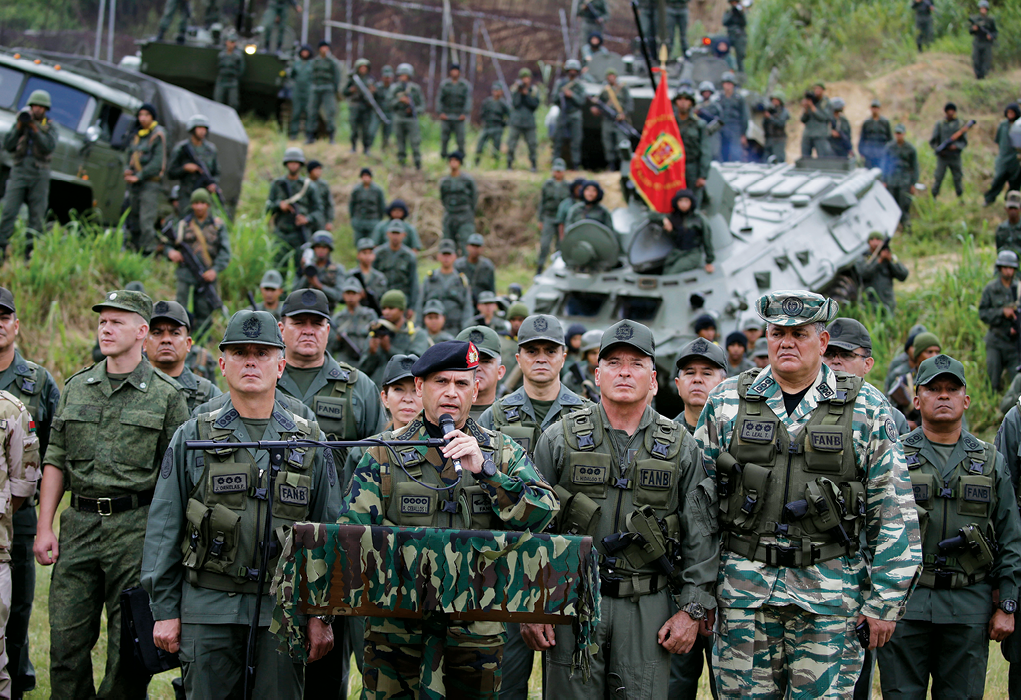Los conceptos vertidos en esta sección no reflejan necesariamente la línea editorial de Nodal. Consideramos importante que se conozcan porque contribuyen a tener una visión integral de la región.Venezuela, A “Black Swan” Hot Spot
Is a Potential Operation in Venezuela Comparable to Operation Just Cause in Panama?
Por Jose L. Delgado*A superpower whipped … 10 percent of the police force of a Third World nation. You are supposed to be able to do that. It was done well, and I credit those who did it. But it is important that we draw the right lessons from it.
—Anonymous U.S. Marine commenting on Operation Just Cause
A black swan is a metaphor for a theory that aims to describe unexpected events of large magnitude and consequence and their dominant role in history. Such events, considered extreme outliers, collectively have played disproportionately larger roles than regular occurrences.1 Recently, I was tasked with reviewing worldwide flash points with potential implications for the United States. During that review, and much to my surprise, a country that kept appearing as a potential outlier (i.e., a black swan) on the list was Venezuela. Although the prospects for a potential U.S. intervention were universally considered low, it was clear from a review of the available information that any intervention (large or small) could easily have broad implications from a regional or hemispheric standpoint.
Venezuela’s crisis—a historic disaster for what used to be one of Latin America’s wealthiest nations—could be an epilogue to the socialist experiment initiated by President Hugo Chávez.2 Chávez, a former military officer who launched an ill-fated coup in 1992, was elected president of Venezuela in 1998 on a populist platform that railed against the country’s elites for widespread corruption; he pledged to use Venezuela’s vast oil wealth to reduce poverty and inequality.3 During his presidency, which lasted until his death in 2013, Chávez expropriated millions of acres of land and nationalized hundreds of private businesses and foreign-owned assets, including oil projects run by ExxonMobil and ConocoPhillips.4
Chávez used the nation’s vast oil wealth to temporarily lift millions out of poverty, but he presided over a system of cronyism and corruption that has potentially enfeebled the country for a generation.5 As a result, the country has been teetering on the verge of a major political and national catastrophe since his death. The economy has shrunk by more than 30 percent since the collapse of oil prices in 2014, the government has defaulted on its external debt, the exchange and price controls have destroyed the productive sector, the oil industry is collapsing, and the purchasing power of Venezuelans has been completely wrecked by rampant hyperinflation.6
Shortages of food, medicine, and jobs instigated massive street riots and the departure of droves of citizens to neighboring countries.7 United Nations statistics from April 2018 documented the exodus of more than 600,000 Venezuelans to Colombia, over 119,000 to Chile, over 39,000 to Ecuador, and 35,000 to Brazil (see figure 1).8 The Brookings Institution recently reported that as many as four million Venezuelans—close to 10 percent of the estimated population—have left the country as a result of the economic crisis.9 Unsurprisingly, the United Nations High Commissioner for Refugees issued a guidance note on the outflow of Venezuelans as the situation showed signs of worsening in early 2018.10
![Figure 1. Venezuelan Migration Routes (Map by Agence France-Presse. Source: UNHCR/ION/USAID/UN DESA/IMP [*forecast]/OPEC)](https://www.armyupress.army.mil/Portals/7/military-review/img/JF-19/Delgado-Fig-1.png)
Venezuelan Black Swan
Caracas is under increasing economic pressure at home as hyperinflation accelerates. The United States and its allies continue to implement sanctions by banning money lending to Venezuela’s government or its state oil company, Petróleos de Venezuela S.A., and by passing sanctions against President Nicolás Maduro and his top officials.12 As oil revenues have continued to fall, the economic unrest continues unabated. One result is that Venezuela has ostensibly been considering a military incursion into Guyana. An unconfirmed report in the Brazilian paper O Antagonista claimed Brazil’s intelligence services had learned about Venezuela considering a military incursion into Guyana for the purposes of claiming oil-rich territory.13
Although it could effectively be argued that Venezuela is far from ready to undertake a foray of this nature, the massive stretch of Guyana’s territory, known as the Essequibo region, has been in contention since 2015 and could theoretically provide the Venezuelan administration a sorely needed distraction from their domestic woes. Maduro, faced with an internal uprising among impoverished and oppressed citizens, issued a presidential decree in June 2015 purporting to claim sovereignty over the entire sixty-five thousand square miles of Essequibo, which accounts for the overwhelming majority of Guyana’s landmass (see figure 2). Also included in the area claimed by Maduro is the vast stretch of ocean where energy giant ExxonMobil, under contract with Guyanese authorities, announced the discovery of huge oil deposits in the deep seabed 120 miles (193 kilometers) off the coast of Guyana in September 2016.14 In his presidential decree, Maduro outlined a “defense” zone offshore that, if allowed to stand, would reportedly block Guyana’s access to the Atlantic Ocean.15

However, the gains could outweigh the risks if the situation becomes grimmer within Venezuela. Stratfor, a private-sector geopolitical analysis organization, believes that a Venezuelan incursion into Guyana could potentially provide some leverage for Venezuela’s ongoing dialogue with the United States by forcing a situation where the Venezuelan government could exchange occupied land for sanctions relief.16 Additionally, Venezuela’s government could potentially use the incursion into Guyana to pump up nationalism among Venezuelans by directing attention outside its borders and gaining time to offset the organized domestic unrest before it becomes more widespread.17
Push for Military Action
Foreign military force as a potential solution to “save” Venezuela has been a topic of discussion since Chávez took power in 1999. Calls for military intervention were also given a boost by U.S. President Donald Trump’s statement in August 2017, which stated that the United States was considering a military option in Venezuela. Despite the White House statement, many countries in the region—Brazil, Colombia, Peru, Chile, Mexico, and Ecuador—vehemently rejected the use of military power in September 2017.18
Since then, the exodus from Venezuela into the surrounding countries has created a humanitarian situation that may have softened the hard stances against intervention within the region. A border crossing in southern Colombia saw the number of Venezuelans traveling or migrating to Ecuador surge from 32,000 in 2016 to 231,000 in 2017.19 An International Organization for Migration report found more than 629,000 Venezuelans living in nine major South American cities in 2017—up from just 85,000 in 2015; but Colombia has borne the brunt of the movement.20 During the latter half of 2017, the number of Venezuelans living there jumped 62 percent—some 50,000 have already arrived during 2018.21
Military Scenario Is Starkly Different from Operation Just Cause (Panama)
If the black swan scenario, as outlined above, materializes and there is Venezuelan military action against Guyana, the United States would ostensibly have a range of options to pressure Venezuela and may choose to implement much heavier economic sanctions. However, it is increasingly likely that it will eventually have to contemplate military action, an action previously considered by many as unpalatable since a wider conflict with the Venezuelan armed forces would be difficult to sustain for the United States as it faces other foreign policy crises across the world.22
Although many parallels have been drawn between the situation in Venezuela in 2018 and Operation Just Cause (OJC), the U.S. military intervention in Panama during 1989, the situations are vastly different. As background, OJC was launched by the United States in December 1989 for four major reasons:
- To safeguard the lives of U.S. citizens in Panama. Then U.S. President George H. W. Bush claimed that Gen. Manuel Noriega, the de facto ruler of Panama (1983–1989), had threatened the lives of the approximately thirty-five thousand U.S. citizens living there. There had been numerous clashes between U.S. and Panamanian forces; one U.S. marine had been killed a few days earlier, and several incidents of harassment of U.S. citizens had taken place.23
- To defend democracy and human rights in Panama. After Guillermo Endara was elected president of Panama, defeating Noriega’s preferred man, Noriega supporters attacked Endara’s motorcade and beat him. In response, Noriega declared the election null and took over Panama as a dictatorship. The Panamanian people reacted to this usurpation of presidential authority by calling for Noriega to step down.24
- To combat drug trafficking. Panama had become a center for drug money laundering and a transit point for drug trafficking to the United States and Europe.25
- To protect the integrity of the Torrijos–Carter Treaties. Members of Congress and others in the U.S. political establishment claimed that Noriega threatened the neutrality of the Panama Canal and that the United States had the right under the treaties to intervene militarily to protect the Panama canal.26
The U.S. invasion resulted in the removal of Noriega and installment in his place of President-elect Endara; the Panamanian Defense Force was also dissolved.27
Though there are superficial similarities between the two situations, there are stark differences. For example, Noriega’s Panama had only fifteen thousand troops—of which, only 3,500 were soldiers.28 The United States had well-established military bases all around the capital and employed a force of over twenty-six thousand men and women of the U.S. Armed Forces during the operation. Also, Panama had fewer than three million people at the time and had a legitimately elected president ready to assume the reins of power after Noriega was removed.29
In stark contrast, Venezuela has 115,000 troops, in addition to tanks and fighter jets. It also has thirty million people, about 20 percent of whom still support the Maduro government. These supporters have an ideology—anti-imperialist socialism—that serves to unify their efforts in coordinated responses to security challenges and explains Maduro’s political resilience to outside pressures.30 Venezuelan leaders have also been preparing for asymmetrical warfare for more than a decade. And, there is no chance that countries in the region would participate in an effort to topple Maduro; Brazil has already stated as much.31
Additionally, the Venezuelan military and its geography, doctrine, and capabilities are largely unfamiliar to U.S. forces—with the notable exception of U.S. Southern Command—which would prospectively be tasked with this mission. If U.S. forces launch an operation into the heavily built-up areas in Caracas, or some of its other outlying areas, aside from having to deal with Venezuela’s conventional forces, they will likely face stiff, armed resistance from irregular forces and opposition in multiple forms from crowds sympathetic to Maduro and his political ideology, including armed uprisings as well as passive popular resistance. Finally, moving the significant amount of U.S. or coalition forces (if we are able to secure coalition assistance) without prepositioned forces or logistics will also have a significant effect on the logistics, timing, and execution of the operation.

Preparation for This Environment
Although U.S. forces have matured significantly since OJC, their actions in Bosnia, Iraq, Bangladesh, Rwanda, and Haiti provide glimpses into some of the operational challenges that will likely surface during a conflict with Venezuela. The U.S. military can (and should) draw practical lessons from these operations; their application in this scenario will almost assuredly improve their performance during any potential operation in or against Venezuela. Considerations that could help military forces incorporate some of the lessons learned from previous U.S. incursions include the topics outlined in the following subsections.
Joint/coalition operations. Efforts to employ and coordinate joint or coalition operations have to take into consideration service-specific needs. Additionally, although multinational forces can bring additional capabilities and capacity to forcible entry, deployment, and redeployment operations, they will always require careful attention to integration.32 At a minimum, any operation that optimizes joint and multinational forces will require careful consideration of equipment interoperability, rehearsals, and liaison teams to facilitate integration.33 Attention also needs to be given to the proper use of special operations forces to ensure that they are properly employed and not overtasked.
Equipment. The hybrid nature (urban, jungle, maritime) of the environment in Venezuela will almost certainly challenge an expeditionary force tasked with military operations. Although great technological advancements have been made since OJC, these technological improvements have not been applied by U.S. forces in the urban and jungle environments prevalent in either Venezuela or Guyana. Moreover, the sharing of this technology in a multinational force environment will likely challenge interoperability and foreign disclosure guidance under which U.S. forces currently operate.
Urban warfare. In a December 2017 Modern War Institute article, Maj. John Spencer states:
There are no urban warfare units in the U.S. Army—not a single unit designed, organized, or equipped specifically for the challenges of operating in cities. There are no research centers dedicated solely to the study of military operations in cities. There are no schools or training sites where Army units can experience, experiment, or train for the challenges of operating in places like Mosul, Aleppo, or Raqqa, where we have seen U.S. and Iraqi forces engaged in high-intensity combat.34
Spencer makes a compelling point about U.S. Army training in urban warfare and offers a cautionary bit of advice for any operation in Venezuela, which, by necessity, will require extensive expertise in urban warfare with very specific guidance regarding the minimum use of force, indirect fire, and aerial bombing. Particularly since the preservation of infrastructure and public utilities will be key to follow-on stabilization operations.
Stability operations. Despite the challenges outlined previously, it is a near certainty that American forces would quickly prevail initially in a military encounter with Venezuela. Having said that, an upfront and comprehensive approach to stability operations by military forces would be required to provide the requisite security and control needed to stabilize the operational area and build a foundation for transitioning to civilian control, and a quick return to normal operation for the host nation.
All tasks must be performed with a focus toward maintaining the delicate balance between long-term success and short-term gains.35 For the forces on the ground, this may mean planning and executing operations within an environment of political ambiguity. As a result, the potentially slow development process of government reconstruction and stabilization policy may frustrate flexible military plans that adapt to the lethal dynamics of combat operations.36 Therefore, in this type of environment, integrating the planning efforts of all the agencies and organizations involved in a stability operation is essential to long-term peace and a relatively quick return to normalcy, similar to what was achieved in OJC.
Interagency approach. In the type of environment described in this article, military forces should not operate independently but as a part of a larger joint, interagency, and frequently multinational effort. Military leaders are responsible for planning, integrating, and executing their operations within this larger effort where integration often involves efforts to exercise, inform, and influence activities with joint, interagency, and multinational partners, as well as efforts to conform military capabilities and plans to larger objectives that are often aligned with strategic and national-level goals.37 By expanding their understanding of potential operational environments through broad education, training, personal study, and collaboration with interagency partners, military leaders will be able to execute operations that set the stage for the quick recovery from combat environments.38 Federal and civilian agencies must not only be involved early in the planning process, but they must also develop the capacities and procedures to offer constructive and timely contributions before, during, and after kinetic operations. Effective integration will require creating shared understanding and purpose through collaboration with all the elements of the friendly force.39

Conclusion
As previously stated, black swan events usually have large and dominant roles in history. Although a military confrontation with Venezuela is widely considered an extreme outlier in the spectrum of potential military conflicts for the United States, such an operation would have a disproportionately large impact on the nature of the United States’ regional influence within the hemisphere. In this context, the question of whether the U.S. military is prepared for such a black swan event gains particular relevance. How the United States and its potential coalition partners execute an operation of this nature while dealing with the sensitivity and the resultant chaos will reverberate for years.
A conflict characterized by urban combat, a complex civilian presence, and the resultant humanitarian demands would require careful planning, training, and execution. Although the United States could easily overpower the smaller Venezuelan combatant forces, the tactics, techniques, and procedures that U.S. combatant units employed in other battlefield scenarios and environments may fall flat in Venezuela and unnecessarily prolong combatant and stabilization operations. Without exceedingly meticulous planning, intervention in Venezuela might quickly develop into an insurgency campaign that could drag on for decades. Therefore, training, doctrine, and equipment would have to be adjusted to accommodate the challenging environment outlined in this article. Fortunately, the experiences gained by the U.S. military since Operation Just Cause can provide valuable lessons for this and other contingency operations and complex military scenarios in bringing them to success.

The views expressed are those of the author and do not necessarily reflect the official position of the U.S. Army, the Department of Defense, or the Department of Homeland Security.
Notes
- Epigraph. “Some Question Whether the U.S. Is Ready for LIC,” Navy News and Undersea Technology, 27 August 1990, 7.
- Nassim Nicholas Taleb,The Black Swan: The Impact of the Highly Improbable, 2nd ed.(London: Penguin, 2010), xxii.
- Ishaan Tharoor, “Venezuela’s Maduro Hollows out His Nation,” Washington Post (website), 1 March 2018, accessed 18 October 2018, https://www.washingtonpost.com/news/worldviews/wp/2018/03/01/venezuelas-maduro-hollows-out-his-nation/.
- Danielle Renwick, “Venezuela in Crisis,” Council on Foreign Relations, last updated 23 March 2018, accessed 18 October 2018, https://www.cfr.org/backgrounder/venezuela-crisis.
- Ibid. Hugo Chávez’s rhetoric often drew inspiration from Simon Bolivar, the Venezuela-born revolutionary of the nineteenth century, and aimed to align Latin American countries against the United States. Chávez led the formation of the Alianza Bolivariana para los Pueblos de Nuestra América (Bolivarian Alliance for the Peoples of Our America, known familiarly as ALBA), a bloc of socialist and leftist Latin American governments, and established the Petrocaribe alliance, in which Venezuela agreed to export petroleum at discounted rates to eighteen Central American and Caribbean states.
- Ibid. Critics of President Nicolas Maduro and his predecessor, Hugo Chávez, say Venezuela’s economic woes are the fruit of years of economic mismanagement; Maduro’s supporters blame falling oil prices and the country’s “corrupt” business elites.
- Robert Malley, “10 Conflicts to Watch in 2018,” Foreign Policy (website), 2 January 2018, accessed 18 October 2018, http://foreignpolicy.com/2018/01/02/10-conflicts-to-watch-in-2018/.
- Phillip Maher, “Five Places to Watch for Conflict in 2018 (2 Photos),” GuelphToday, 10 February 2018, accessed 18 October 2018, https://www.guelphtoday.com/columns/mercy-traveller-with-philip-maher/five-places-to-watch-for-conflict-in-2018-2-photos-835552.
- “How Venezuela’s Crisis Developed and Drove out Millions of People,” BBC News, 22 August 2018, accessed 1 November 2018, https://www.bbc.com/news/world-latin-america-36319877.
- Dany Bahar, “Venezuela’s Refugee Crisis Will Exceed Syria’s; We Must Help,” Brookings Institution, 12 February 2018, accessed 18 October 2018, https://www.brookings.edu/opinions/venezuelas-refugee-crisis-will-exceed-syrias-we-must-help/. The estimates of refugees who left Syria during the war account for about five million individuals. Considering that the situation on the ground is ostensibly deteriorating and the lack of food and medicine in Venezuela will probably get much worse, the four million figure will likely rapidly increase.
- Office of the UN High Commissioner for Refugees, “Guidance Note on the Outflow of Venezuelans,” 1 March 2018, 1, accessed 18 October 2018, https://data2.unhcr.org/en/documents/download/63243.
- Ricardo Hausmann, “D-Day Venezuela,” 2 January 2018, accessed 18 October 2018, https://www.project-syndicate.org/commentary/venezuela-catastrophe-military-intervention-by-ricardo-hausmann-2018-01?barrier=accesspaylog.
- Cristina Silva, “Venezuela Prepares for War with U.S. with ‘Rifles, Missiles and Well-Oiled Tanks at the Ready,’” Newsweek (website), 26 September 2017, accessed 18 October 2018, http://www.newsweek.com/venezuela-prepares-war-us-rifles-missiles-and-well-oiled-tanks-ready-672033.
- “Would Venezuela Invade Guyana?,” Stratfor Worldview, 8 February 2018, accessed 18 October 2018, https://ronaldwederfoort.wordpress.com/2018/02/13/guyana-would-venezuela-invade-guyana/.
- Alex Newman, “Venezuelan Strongman Wants to Seize 2/3 of Neighboring Guyana,” The New American (website), 7 August 2015, accessed 18 October 2018, https://www.thenewamerican.com/world-news/south-america/item/21374-venezuelan-strongman-wants-to-seize-2-3-of-neighboring-guyana.
- “Would Venezuela Invade Guyana?”
- Ibid.
- David Smilde, “Should the United States Attack Venezuela?,” New York Times (website), 14 January 2018, accessed 18 October 2018, https://www.nytimes.com/2018/01/14/opinion/united-states-venezuela-attack.html.
- Christopher Woody, “‘I Don’t Have a Happy Ending’: Venezuela’s Misery Is Deepening—and Spilling over Its Borders,” Business Insider, 13 February 2018, accessed 18 October 2018, http://www.businessinsider.com/venezuelan-migration-creating-humanitarian-problems-in-other-countries-2018-2.
- International Organization for Migration, “Findings on Colombia-Venezuela Border Migration Highlighted in UN Migration Agency Study,” press release, 7 July 2017, accessed 18 October 2018, https://www.iom.int/news/findings-colombia-venezuela-border-migration-highlighted-un-migration-agency-study.
- Woody, “‘I Don’t Have a Happy Ending.’”
- Ibid. Although migration has continued unabated, UN sources have not compiled and released precise data for 2018.
- Jennifer Morrison Taw, Operation Just Cause: Lessons for Operations Other Than War (Santa Monica, CA: RAND Arroyo Center, 1996), 7, accessed 18 October 2018, https://www.rand.org/content/dam/rand/pubs/monograph_reports/2007/MR569.pdf.
- “What is Operation Just Cause?,” accessed 18 October 2018, http://www.operationjustcause.us/index.html; U.S. President George H. W. Bush, on the morning of 20 December 1989, stated that Manuel Noriega had declared a state of war existed between the United States and Panama.
- Ibid. U.S. Southern Command kept a list of abuses against U.S. servicemen and civilians by the Panamanian Defense Forces (PDF) while the orders to incite PDF soldiers were in place.
- Ibid. The United States had turned a blind eye to Noriega’s involvement in drug trafficking since the 1970s. Noriega was then singled out for direct involvement in these drug trafficking operations due to the widespread public knowledge of his involvement in money laundering, drug activities, political murder, and human rights abuses.
- Ibid. Although the canal was destined for Panamanian administration, the military bases remained and one condition of the transfer was that the canal would remain open for American shipping.
- Ibid.
- Smilde, “Should the United States Attack Venezuela?”
- Ibid.
- Ibid.
- Joint Publication (JP) 3-18, Joint Forcible Entry Operations 11 May 2017 (Washington, DC: U.S. Government Publishing Office [GPO], 9 January 2018, incorporating change 1), viii.
- JP 3-35, Deployment and Redeployment Operations (Washington DC: U.S. GPO, 10 January 2018), I-2. Conditions that have historically led to the successful implementation of force integration are usually governed by a DOTMLPF-P framework (doctrine, organization, training, materiel, leadership and education, personnel, facilities, and policy) that ensures effective interagency integration across the full spectrum of Department of Defense operations.
- William J. Denn, “Search for the Philosopher’s Stone: Improving Interagency Cooperation in Tactical Military Operations,” Modern War Institute at West Point, 27 March 2018, accessed 18 October 2018, https://mwi.usma.edu/search-philosophers-stone-improving-interagency-cooperation-tactical-military-operations/; John Spencer, “A Soldier’s Urban Warfare Christmas Wish List,” Modern War Institute at West Point, 19 December 2017, accessed 18 October 2018, https://mwi.usma.edu/soldiers-urban-warfare-christmas-wish-list/.
- Field Manual 3-07, Stability Operations (Washington, DC: U.S. Government Printing Office, October 2008 [obsolete]), vii.
- Ibid.
- Army Doctrine Publication 3-0, Unified Land Operations (Washington, DC: U.S. Government Printing Office, October 2011 [obsolete]), 7-9.
- Morrison Taw, “Operation Just Cause,” 9.
- Ibid. This central idea applies to all military operations—offensive, defensive, and stability or defense support of civil authorities. This unifying principle connects the various tasks military forces may perform.
- Ibid.
(*) Jose L. Delgado is a member of the Senior Executive Service within the Department of Homeland Security (DHS) and currently works as the director of the Counterintelligence Mission Center DHS Office of Intelligence and Analysis. He has an undergraduate degree in coastal marine biology and a graduate degree in adult education and distance learning. As a U.S. Army military intelligence officer, he served in a myriad of combat operations, including Operation Just Cause and Operations Desert Shield and Desert Storm, as well as military advisory duties during the El Salvadoran Insurgency.Army University Press

